
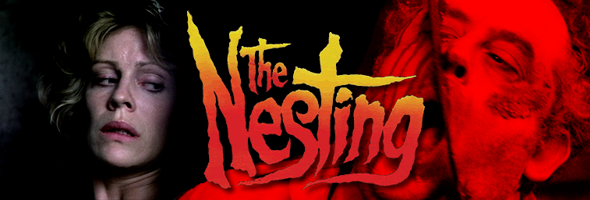
Color, 1981, 109 mins. 58 secs. / 103 mins. 21 secs.
Directed by Armand Weston
Starring Robin Groves, Christopher Loomis, Michael David Lally, Gloria Grahame, John Carradine, Bill Rowley
Vinegar Syndrome (UHD & Blu-ray) (US R0 4K/HD), Blue Underground (US R0 NTSC) / WS (1.85:1) (16:9)
Largely dismissed upon 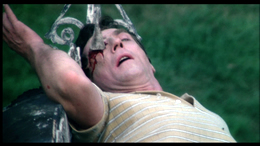 its release during the formative years of '80s slasher mania, The Nesting is a unique ghost story that's aged in fascinating ways
its release during the formative years of '80s slasher mania, The Nesting is a unique ghost story that's aged in fascinating ways 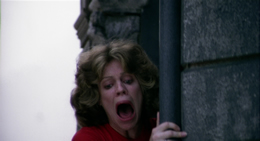 over the years. Thanks to a striking central haunted house, a unique combination of a kinky traumatic past and an unstable heroine, and several stylish directorial flourishes, it's a nifty little spook show if you're willing to go along with its deliberately paced revelations and ignore some goofy plot inconsistencies.
over the years. Thanks to a striking central haunted house, a unique combination of a kinky traumatic past and an unstable heroine, and several stylish directorial flourishes, it's a nifty little spook show if you're willing to go along with its deliberately paced revelations and ignore some goofy plot inconsistencies.
After suffering a panic attack in the middle of a city street, snippy thriller novelist Lauren Cochran (Silver Bullet's Groves) is diagnosed with agoraphobia and decides to go out to the countryside to work on her latest book. Her house hunting brings her to a strange octagonal house identical to the one she wrote about in her last novel, The Nesting. She decides to rent the place and finds that on her first night there, she's able to vividly remember the erotic nightmares which have been plaguing her night after night before without any recall. Soon details about the house begin to emerge; it was once a brothel where a notorious bloodbath occurred, and now people around Lauren are starting to die horrifically. What do the ghosts left in the house want, and can she escape?
The Nesting is probably best known now for two factors. First, it was the final film for actress Gloria Grahame, who plays the house's ghostly madam. A longtime Hollywood veteran of films like The Big Heat and In a Lonely Place, she's a surprising choice for an '80s horror film but pulls it off well considering the limited nature of her role. 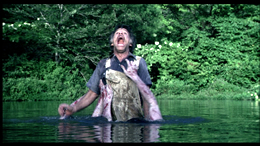 For extra measure, John Carradine also pops up in an extended cameo, basically a slight tweak on the same role he
For extra measure, John Carradine also pops up in an extended cameo, basically a slight tweak on the same role he 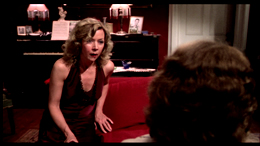 played earlier in The Sentinel.
played earlier in The Sentinel.
The other major curiosity factor here is the fact that this was the only legit film directed by Armand Weston, one of the most talented '70s hardcore filmmakers but hardly the most prolific. However, the choice to do a flat-out horror film isn't so odd considering his most famous film, 1975's The Defiance of Good (starring Last House on the Left's Fred Lincoln), is as much a Gothic terror tale as a particularly twisted roughie. All of his films have a distinctively dark, inky look to them that's both eerie and distinctive, especially in perhaps the best film out of his filmography, the gritty and exceptionally well-directed The Taking of Christina. His other two big features from the '70s, the Hollywood pastiche Take Off and the noir homage Expose Me, Lovely, are nothing to sneeze at, either. Perhaps because of his elaborate shooting style and frequent attention to production design details, Weston made a much smaller amount of films than his peers but is still remembered as one of the era's pioneers with good reason.
Now that brings us back to The Nesting, his final credited feature film before he passed away in 1988. The film is shot with a similarly shadowy, colorful style as his earlier films (and weirdly, two of the actors bear more than a passing resemblance to porn stars John Leslie and Kevin James), and the approach adapts surprisingly well to a modern ghost story. The plot itself is basically a pastiche of films like The Changeling and The Haunting of Julia, though the novel gimmick of a haunted whorehouse was recycled again in 1988 for Heart of Midnight, which owes more than a nod to this film. The erotic content here is less than one might expect given the director, though a memorable mirror nude scene and some nightmarish flashback/fantasies easily give away the identity behind the camera.  The film also pulls off a handful of brief but memorable gore highlights as well, including a scythe gag that would make Jean
The film also pulls off a handful of brief but memorable gore highlights as well, including a scythe gag that would make Jean  Rollin proud and even a bit of Fulci-style eyeball mayhem.
Rollin proud and even a bit of Fulci-style eyeball mayhem.
The Nesting received a pretty negative critical reputation from reviews over the years, but a lot of that could be blamed on its atrocious treatment on home video for decades. The biggest offender was Warner's transfer made for VHS release in the early '80s, and it's a complete train wreck: muddy, far too dark, and completely distorted colors, to name just a few of its problems. The scenes with Lauren exploring the house were rendered especially useless, turning into endless stretches of a barely visible face bobbing around in almost total darkness.
Blue Underground's much-needed resuscitation of the film for a Blu-ray and DVD release in 2011 had to be considered a revelation simply by default; you can finally see what's going on, and colors are back to their original saturation levels. It's definitely not the sharpest or slickest-looking film of its era; compared to the startling clarity of, say, My Bloody Valentine, it's really no contest at all. However, taken on its own terms, this was a tremendous upgrade and a far preferable way to experience this film than the sorry video versions and chewed-up, faded theatrical prints we've had to put up with before.
Surprisingly the film was outfitted with three language options: lossless English DTS-HD 7.1, Dolby Digital 5.1, and the original mono. Though not authentic, the 7.1 version is surprisingly spacious with some nifty directional effects, especially in the slightly ridiculous everything-but-the-kitchen-sink ending that feels like it stepped out of Norman J. Warren's Terror. The creepy music score also benefits from the additional separation as well; however, purists who like their '80s horror stripped-down and rough may opt for the mono anyway. English SHD subtitles are offered along with French and Spanish. The most substantial extra is about 12 minutes of deleted scenes; even at 103 minutes, the film originally ran longer in Weston's first cut and had to be trimmed down before distribution. The footage here is basically all exposition, though some of it (the extended therapy scenes especially, which clarify her relationship with Mark) would have made for much smoother and more logical transitions than what's in the final cut. Other extras include the American and Spanish trailers (which make this look a lot like The Boogeyman), three TV spots, and a massive gallery of art, stills, and location photos including multiple posters (some with the  alternate titles of Phobia and Massacre Mansion) and Armand Weston's original oil painting for the poster art.
alternate titles of Phobia and Massacre Mansion) and Armand Weston's original oil painting for the poster art.  Most amusingly, it also includes some MPAA documentation, a legal letter about the title change from Phobia, and a New York Post article about the irate owner of the actual house who claims, "They vandalized like hell... They were animals. They urinated on the bathroom floor." That could've made another movie unto itself.
Most amusingly, it also includes some MPAA documentation, a legal letter about the title change from Phobia, and a New York Post article about the irate owner of the actual house who claims, "They vandalized like hell... They were animals. They urinated on the bathroom floor." That could've made another movie unto itself.
In 2025, Vinegar Syndrome revisited the film as a UHD and Blu-ray set featuring a fresh scan from the original camera negative, reconstructed to Weston's original 109-minute cut with the Phobia title card. As you'd expect the many years since it's last release have allowed transfer technology to progress quite a bit, and the presentation looks great here with the UHD in particular featuring an impressive color gamut thanks to HDR10-compatible Dolby Vision. The color timing here is more consistent than the Blue Underground, which by comparison had a blue or pinkish tinge in some scenes especially when it came to flesh tones. The DTS-HD MA English 2.0 mono track is true to the original theatrical mix and comes with optional English SDH subtitles. A new commentary track with writer and critic Andy Marshall-Roberts is a solid listening going through the film's place in the U.K.'s video nasty heyday, connections to other horror films around the same time, Weston's background and repertory players and technicians, echoes of fairy tales like Frau Holle, and parsing out the interplay of past and present in the film both visually and aurally. You also get a 57-minute audio interview as a separate track with co-writer Daria Price, conducted by extras producer Ewan Cant, about Weston's background including his work as a painter and illustrator, her wild time working on "the illustrious" Dawn of the Mummy, her involvement in the production of this film including script supervision, and more. In “Acting is Being Brave” (20m39s), Groves chats about her move into acting after studying psychology, her experiences in New York theater including an intimidating plunge opposite Vanessa Redgrave, her thoughts on doing nudity for the first time in this film, her memories of the house location, and her overall career in film and TV. Then "The Outlaw Poet" (21m2s) features actor Michael David Lally looking at his "creative existence," his experiences with acting including improv, the story behind his big tearful scene opposite John Carradine, and the life experiences he generated into his work as well as his fondness for his leading lady. "Low Budget Miracle" (30m32s) is an interview with associate producer / production manager Don Walters about working with Weston, wrangling the central location, the personnel involved from Take Off, the rationale for doing a horror film, and the budgetary restrictions that hit big scenes like a car chase. In "The Sating of Desire" (28m39s), region horror expert and author Stephen Thrower looks at the somewhat sluggish road to getting the film made and released, the legal issues over the original title and the damage to the location, the rationale behind a reissue as Massacre Mansion, odd side projects of the talents involved, and the strong points of the film including its invaluable choice of house. The interesting "The Nesting Outtakes: Preserving Armand Weston’s Gothic Horror" (14m22s) produced by the Vinegar Syndrome Film Archive features Distribpix's Steven Morowitz and VS's Oscar Becher explaining how this film and the company library in general were transported, transfered, and released, as well as the background of the company co-founded by Morowitz's father and the intricacies of rifling through all the boxes for this film in particular. Finally you get the U.S. and Spanish trailers, three TV spots, a radio spot, an alternate 1m11s "jump scare" moment involving Grahame created for the theatrical release, the title sequence as The Nesting, a 5m17s gallery, an 8m56s reel of various silent cuts and trims (including some fun car chase bits), and an 11m26s batch of unused silent dailies including some longer looks at the haunted whorehouse flashbacks in particular.
Vinegar Syndrome (Blu-ray)





Blue Underground (Blu-ray)





Updated review on May 7, 2025.





 its release during the formative years of '80s slasher mania, The Nesting is a unique ghost story that's aged in fascinating ways
its release during the formative years of '80s slasher mania, The Nesting is a unique ghost story that's aged in fascinating ways  over the years. Thanks to a striking central haunted house, a unique combination of a kinky traumatic past and an unstable heroine, and several stylish directorial flourishes, it's a nifty little spook show if you're willing to go along with its deliberately paced revelations and ignore some goofy plot inconsistencies.
over the years. Thanks to a striking central haunted house, a unique combination of a kinky traumatic past and an unstable heroine, and several stylish directorial flourishes, it's a nifty little spook show if you're willing to go along with its deliberately paced revelations and ignore some goofy plot inconsistencies.  For extra measure, John Carradine also pops up in an extended cameo, basically a slight tweak on the same role he
For extra measure, John Carradine also pops up in an extended cameo, basically a slight tweak on the same role he  played earlier in The Sentinel.
played earlier in The Sentinel.
 The film also pulls off a handful of brief but memorable gore highlights as well, including a scythe gag that would make Jean
The film also pulls off a handful of brief but memorable gore highlights as well, including a scythe gag that would make Jean  Rollin proud and even a bit of Fulci-style eyeball mayhem.
Rollin proud and even a bit of Fulci-style eyeball mayhem.
 alternate titles of Phobia and Massacre Mansion) and Armand Weston's original oil painting for the poster art.
alternate titles of Phobia and Massacre Mansion) and Armand Weston's original oil painting for the poster art.  Most amusingly, it also includes some MPAA documentation, a legal letter about the title change from Phobia, and a New York Post article about the irate owner of the actual house who claims, "They vandalized like hell... They were animals. They urinated on the bathroom floor." That could've made another movie unto itself.
Most amusingly, it also includes some MPAA documentation, a legal letter about the title change from Phobia, and a New York Post article about the irate owner of the actual house who claims, "They vandalized like hell... They were animals. They urinated on the bathroom floor." That could've made another movie unto itself.![]()